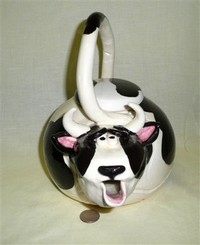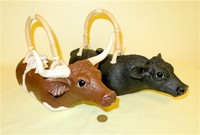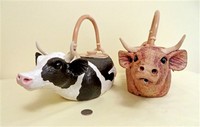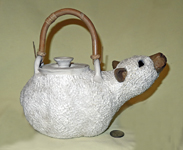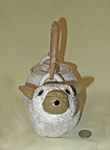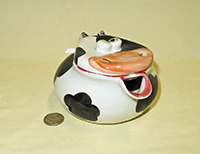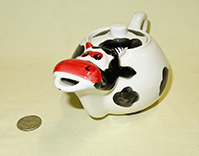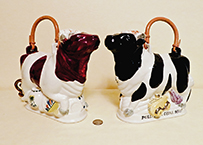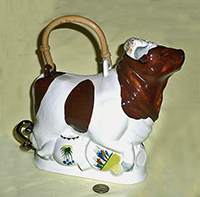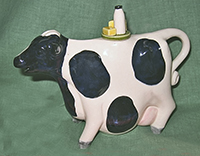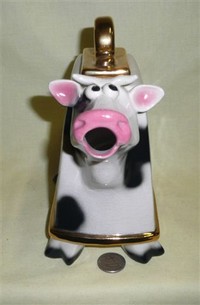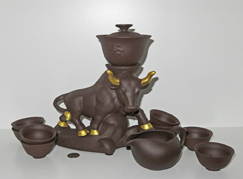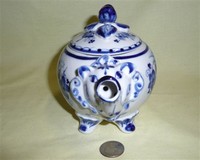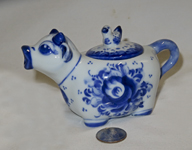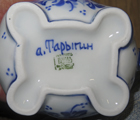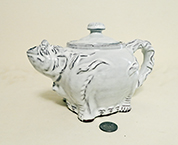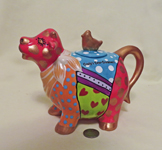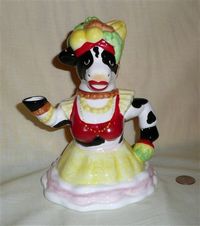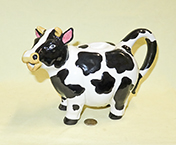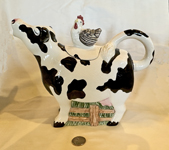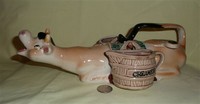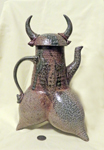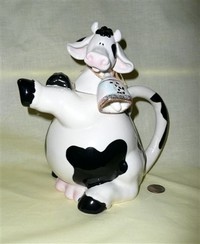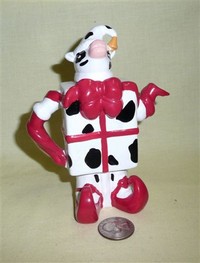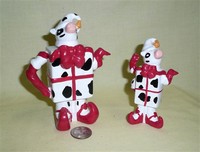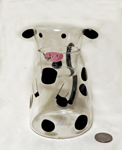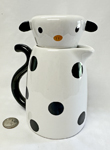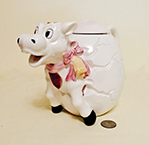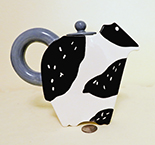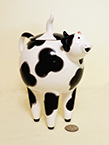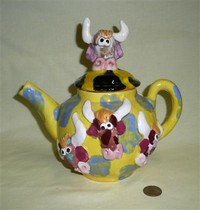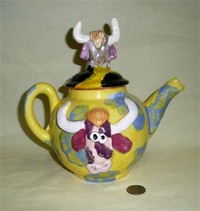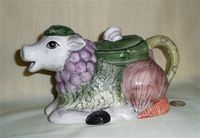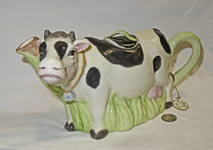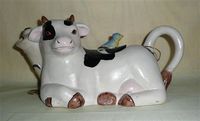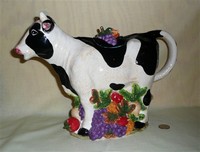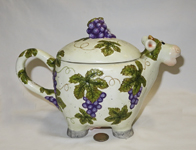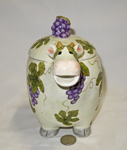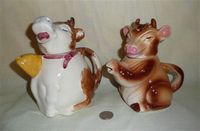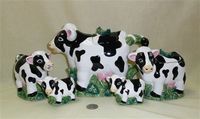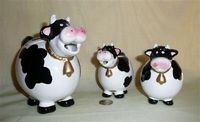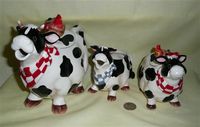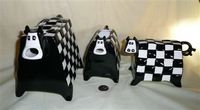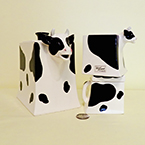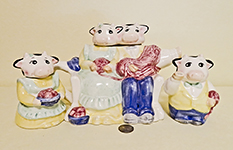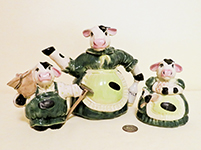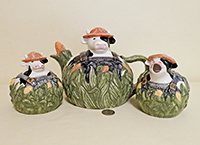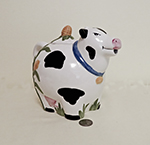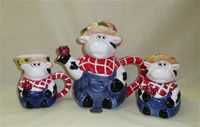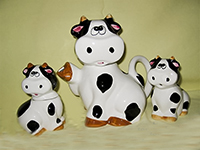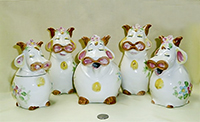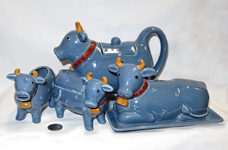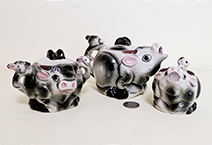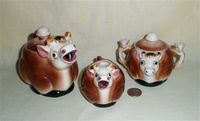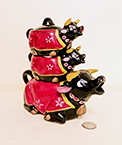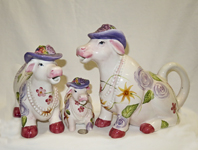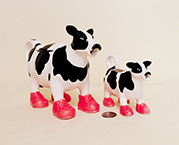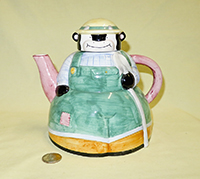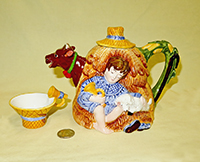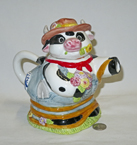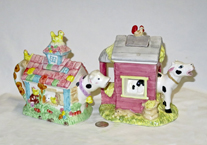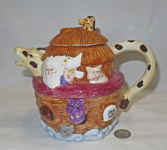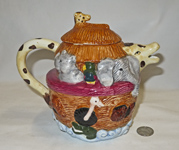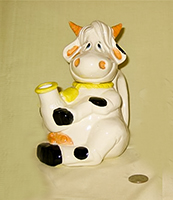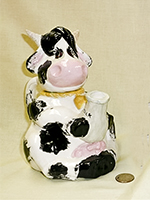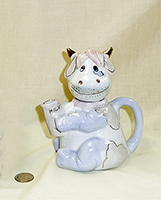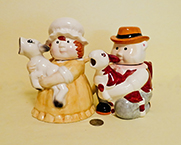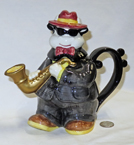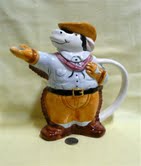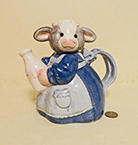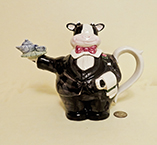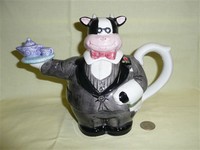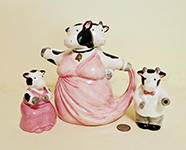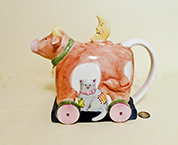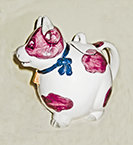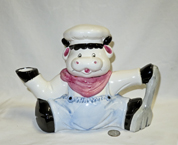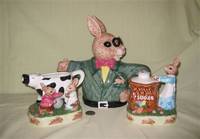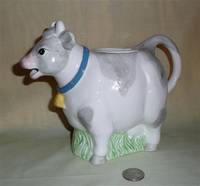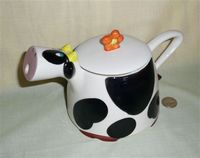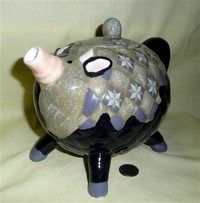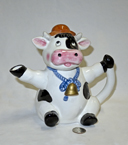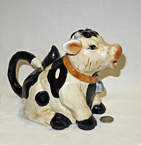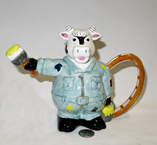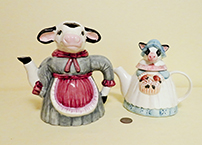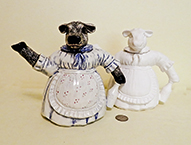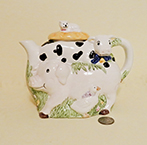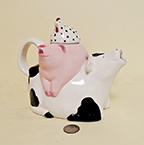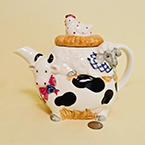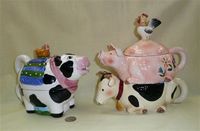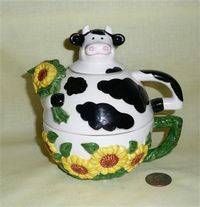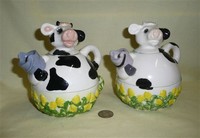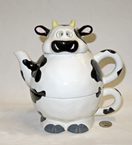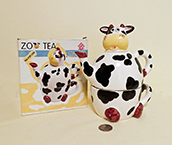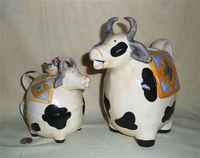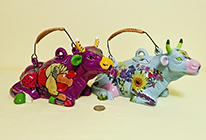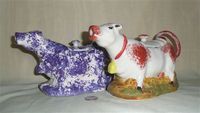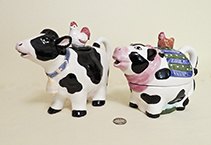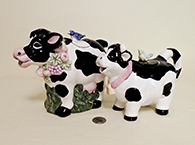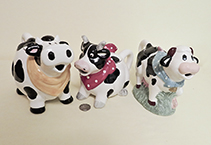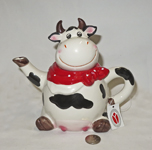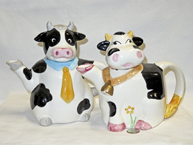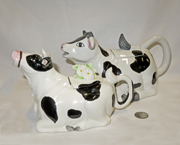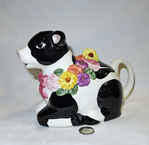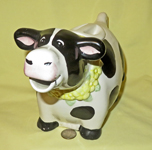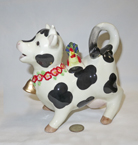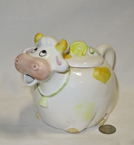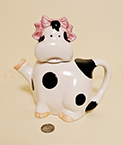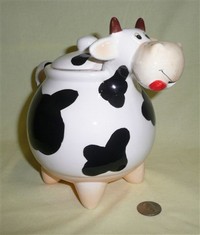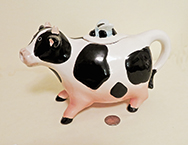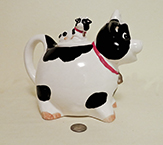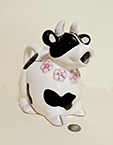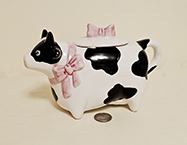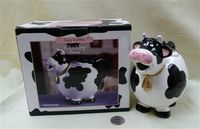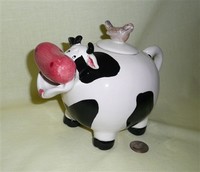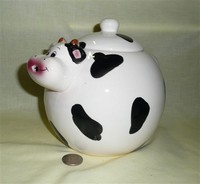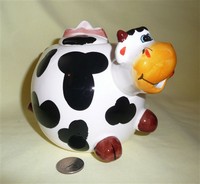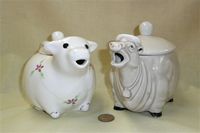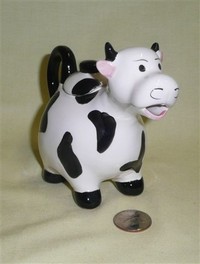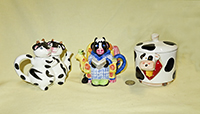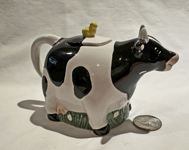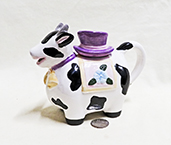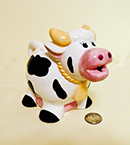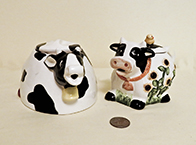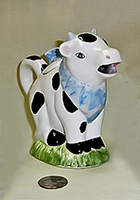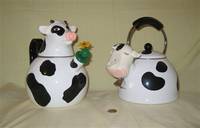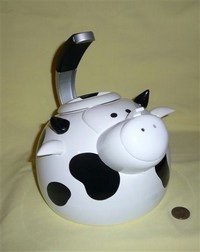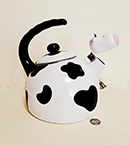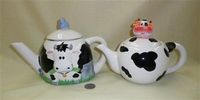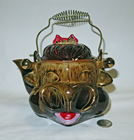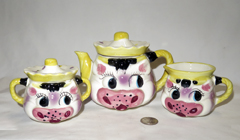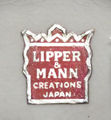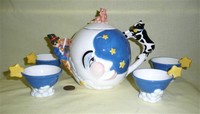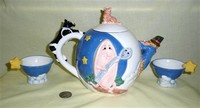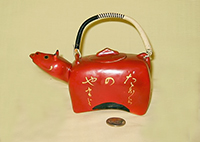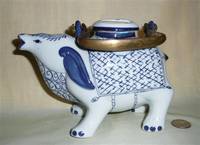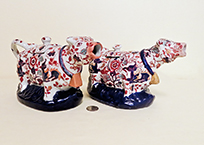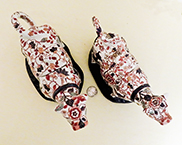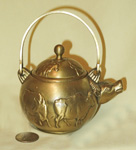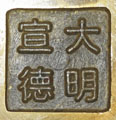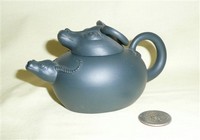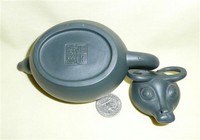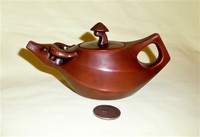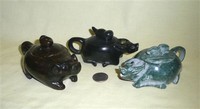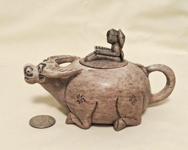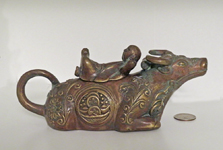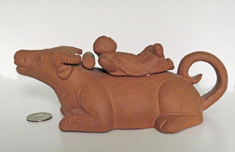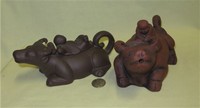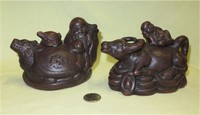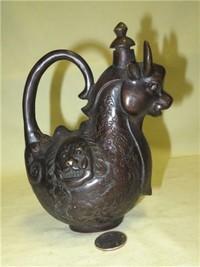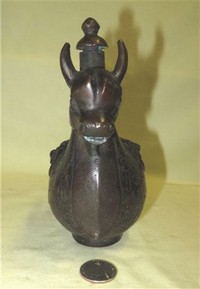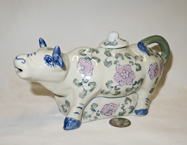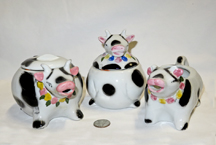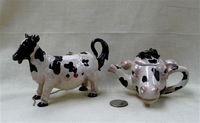
Teapots
The teapot part of the collection started somewhat accidentally, when I had to buy a teapot in order to get a cow creamer that I wanted. Then – just like with the silver and Staffordshire cow creamers – when we moved to England for a couple years, things changed. I think the one that really got me hooked on cow teapots was Andy Titcomb’s ‘Bull in a China Shop’ (see below…), which we found in a lovely tea shop on Neal Street, just north of Covent Gardens. But then, if it hadn’t been one of his, it probably would have been one of the others. So now there are over two hundred twenty five, most here, some shown in other theme sections.
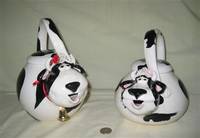
|
These two are my favorites. We bought both in Virginia, one directly from the artisan at a craft fair in Gaithersburg in 1995, the other in a gift shop in the summer of 2007. They are hand crafted by Carol E. Myers of Chincoteague Island, Va. She makes a number of other animal teapots as well. Her shop was closed when we visited the island for a birding trip in 2015, so I’m very glad I bought these while she was still working. |
|
|
Here’s a third from Carol Meyers, that I got via eBay (much cheaper than in the store or at the fair!). I believe it is an early version since it lacks some of the ‘frills’ of the others and seems to have a somewhat cruder head. |
||
|
||
|
||
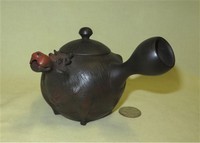 |
This lovely small Japanese red clay teapot was hand-crafted by the noted craftsman Kameoka Katushi, a 4th generation potter of the “Motozo Kiln” in Tokoname, Japan. He is noted for his bonsai pots as well as his fanciful and beautifully crafted teapots. Wikipedia tells us that Tokoname was the location of one of the ‘Six Ancient Kilns’ of Japan, and that pottery from the town dates back to the 12c. Ceramics production and commercial fishing are major components of the local economy. |
|
|
This folk-art caricature is also hand-made, but from where and by whom I have no idea. It came via eBay, and bears the mark “DN86” on the left front leg. |
||
 |
|
|
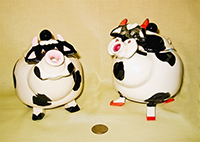 |
I have purchased quite a number of cow creamers and pitchers both in Australia and from eBay.au, but these two little handmade teapots, from Ron and Lorrie Holmes-Brown of Queensland, are the only ones I know of that were definitely made there. | |
|
||
|
||
|
||
|
||
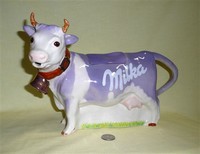 |
This large (8”x12”) and beautiful cow teapot was an early design of Paul Cardew’s, dating from the 1980’s when he was trading as South West Ceramics. He is probably better known among cow teapot aficiandos for his bottles with a cow head sticking out, shown with some more information about him a few sections down. I acquired this lovely “Milka” cow (via eBay) from Sue Blayze of Tea Pot Island. I believe she holds the world record for teapot collections – she has some 6400 of which 1600 or so are displayed and discussed on her marvelous website, www.teapotisland.com. If you are at all interested in teapots, this is a must-visit site. She noted that this one is ‘rare’ – I had earlier bought one that broke in shipment (lousy packaging) from a chap who said there were only 250 made – but that it was also made in brown and black. I suppose this one could go in “the “Advertising” section since it’s a lovely rendition of the Milka purple cow and proudly bears the brand name. For those of you that don’t know Milka, well, you’re missing something very tasty. |
|
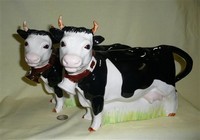 |
Here is the black and white version of the ‘Milka’ cow – why two of them? Well, just like Milka the first one I bought arrived broken, although in this case I was able to decently patch it up. But when another one came up on offer a year or so later, I was able to work with the seller to arrange safe, if expensive, shipping.
|
|
| ||
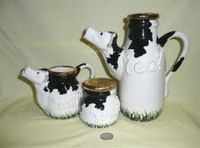 |
Here’s the resulting “Cardew Designs 2000” cow tea set including the sugar bowl and creamer. From the Cardew Design North America Inc (established in 1999 to increase business in the US and Canada) website we learn that Paul Cardew attended art school at Loughborough University, then taught art part time at Exeter University. He broke into commercial work with successful commissions for ceramic brooches for Harrods and piggy banks for the National Westminster Bank, then launched his teapot designs in 1975 at the Birmingham spring fair. His initial company, Sunshine Ceramics (we learn from Andy Titcomb’s website that Sunshine Ceramics was started by Paul along with his wife Karen, and Hillary Watters and her partner David Symonds, and that Andy joined them in 1978 and left in 1983), transitioned into Cardew Design in 1991, and they entered North American markets in 92. Cardew has designed for a number of well known brands including Portmerion and Royal Dalton, but most famously for Disney for which he did over a hundred designs. The North America company acquired the international rights to the Cardew name and trademarks in 2008, and continues to produce new designs. |
|
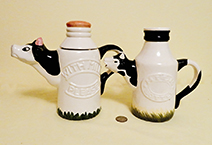 |
Apparently the Cardew teapots were sufficiently popular that they inspired knock-offs, or at least someone else had the same idea. The smaller one simply says "Milk Bottle" but the larger one has "With Milk Please" on one side, and "SWC Teapot Co." on the other, not to mention "made in China". |
|
|
|
|
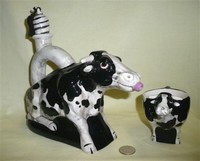 |
Here is magnificent teapot by another well known ceramics artist, Tom Hatton. There are three of his creamers in the ‘Favorite Brands’ page – and here is a matching teapot and cup, dated 1992. The story about him on his web page, www.tomhattonceramics.com, notes that his commercial work began with the American Craft Council in 1983, and that in 1995 he switched to doing more one-of-a-kind pieces. This teapot and cup thus came from his more ‘commercial’ period. Be that as it may, he crafts really fun cows. | |
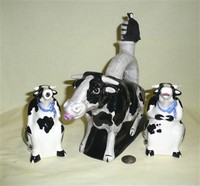 |
Here’s the same teapot again, this time with a matching (at least also from 1992) sugar and creamer. | |
|
||
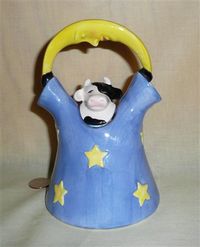 |
This is a very cute and original interpretation by CLAY ART of San Francisco, copyrighted 1993, logically entitled "Cow Under the Moon", and made in China. I have a number of pieces of from them, but the only information I could glean from the web came from a 1997 About.com article http://collectibles.about.com/library/articles/aa061797.htm that notes: “In 1979 Michael Zanfagna and Jenny McClain were teaching at Mission High School in San Francisco, when they decided to build a business of affordable art.” They made salt and pepper shakers, cookie jars, and similar items…obviously including the occasional amusing cow. Are they still in business? |
|
|
||
|
||
|
This whitish and silver cow bears a slight family resemblance to the first Gzhel teapot, but it’s unmarked. It could as easily be some sort of mythical beast as a cow, but of course I had to get a close-up look so couldn’t resist buying it. |
||
 |
Not Russia this time, but the Ukraine – from a small company that calls itself Ceramic Wood. I found these on Etsy – which seems to be a good place for international sellers to reach a wide market. Cute idea for teapots (they listed them as pitchers), and they come in a wide variety of colors. |
|
| This very colorful rotund teapot came all the way from Malaysia. It's sort of special because the seller gave it a name, "Craig's Cow Creamers" in raised small black letters. It was actually a bit of a hassle to get it because the shipping to Alaska was exorbitant and I had to cancel the order then reorder for a Virginia address. It came with a couple cute tea cups. | ||
|
|
This “hot mama” was made in China. Cute, and hard to ship withoput breaking, I found to my dismay. |
|
|
Here’s Vandor’s “Cowmen Mooranda” of 1988 in the teapot version – there’s also a large pitcher that’s shown in the Heads theme. |
||
|
With a gourd-shaped body and bulbous nose, this teapot made a long trip to me from Australia. It's unmarked but I'd imagine it was made somewhere north of there. |
||
|
This fun caricature comes from Blue Sky Clayworks, and was created by Canadian artist Heather Goldminc. You can read about her and her work on her homepage, www.heathergoldminc.com |
||
|
Heather did more than one cow teapot for Blue Sky, and they weren't all wierd. Not completely realistic, this one, but at least it has all of its parts in the right places. And once you have read about Heather, you can find out more about the company that's located in Ontario, CA and is "Your Source for Exceptionally Designed Ceramic Tabletop Products", at www.blueskyclayrorks.com . If you thought the cow teapots were wild, you should check our some of their others. Pricey, but very nice. |
||
Heather didn't make this one, indeed I have no idea who made it but it's from China. She is a very happy cow, proud of her chicken lid, and seems to be singing. |
||
|
||
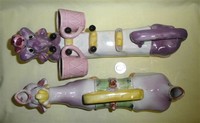 |
If you think those are weird, try these. The one with the dark purple head, knobby horns and bulgy red nose (which is actually a stopper) is most likely from Thames of Japan. It still has a couple of the cups that are supposed to hang on the little hooks (these are the ones I ‘borrowed’ for use with the rhinestone long-neck), but also has had a couple of its hooks broken off. Its companion has a hole at either end, and is designed to hold two different liquids. I tried it and it does indeed have two separate compartments. Presumably it originally came with a sugar and creamer like the ones above. |
|
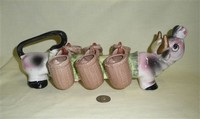 |
This variation on the long-skinny-funny-looking-cow theme comes with 6 cups each stamped “Japan” but with only a single hole, under the nose stopper. Heavens knows whether it was intended to hold tea, sake, or whatever… |
|
More weird. Heavy ceramic, sold as a bull but then bulls don't have three of those bulgy things at the bottom to rest upon. Certainly unusual - handmade. I learned a bidding lesson with this one. On an eBay auction, if no one else has bid and you really think you want it but will bid higher or 'snipe' later, put in a miniumum bid so it can't be withdrawn. Well, that's what I did here even though I wasn't sure I wanted it - figured someone else would since it was so cheap, but - lucky me - I got it for 99 cents (plus of course a large shipping fee). |
||
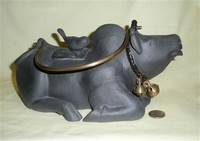 |
This stoneware teapot with brass bells around the neck is entitled “Buffalo and Bird Friends”, and was bought from Novica, which operates in association with National Geographic and sells all kinds of articles crafted by artists and artisans from several countries in South America, Africa and Asia. This lovely teapot came from Bali or Java and was made (their site informs me) by Tat Yan Soo, who “was born in November 1955. As a lover of nature and avid gardener, he wanted to create designs that revolved around flora and fauna. He also loves to cook, so he strives to craft products that are decorative, functional and durable.” |
|
|
This floppy eared black and white cow wins the prize for the biggest ceramic bell. It bears a 2001 copyright mark, is called “Oh My Darling Cow”, and hails from “Ontario CA 91761, Handcrafted in China, © Character Collectibles. |
||
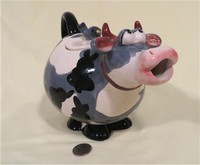 |
I always try to find a cow creamer or teapot when my wife and I take an overseas trip. I do have a Latvian creamer that I bought through eBay, and thus had high hopes for our jaunt through the Baltic nations, but was devoid of success until near the end, when I found this teapot in a teashop in Vilnius, Lithuania. Unfortunately it’s not Lithuanian – rather it is marked for “Jameson & Tailor, Artists of the World, strange 200”, a German company whose bilingual website www.jameson-tailor.de proudly states “Tea and coffe (sic) accessories are our passion”. |
|
|
||
|
||
|
||
|
||
|
This ‘veggie’ calf is marked for CBK Ltd of Taiwan (to learn more about CBK, check out the aluminum cow creamer near the bottom of page 3 of Modern Variations), and dated 1988. |
||
|
||
|
Here is a second Klein cow teapot, this time with a milk bottle coming up from the back for a spout and a bluebird on the lid. This Bangkok company seems to have a predeliction for unusual spouts, at least on their cow teapots. I wonder if there are more? |
||
 |
This simple pure white lazy teapot is unmarked. |
|
 |
This rather large brown and white cow is also unmarked, but bears a rather colorful roosted on its back. It came damaged, with a re-glued left ear, but I have never seen another like it. |
|
|
Here’s a large pretty Holstein decorated with fruit and vegetables from the Signature Home Collection, made in China. I bought this one on eBay in 2004. I liked it enough that a few years later I got a duplicate, complete with box. |
||
|
||
|
Seemingly identical, these three teapots have somewhat different histories. The one on the right, which came to me from Germany, is stamped for “Erphila, Germany” and bears the mold mark 718. Erphila ia the mark used by Ebeling and Reuss, a giftware importer and distributor founded in 1886 in Philadelphia (thus E…R…Phila) and sold to Strathmore Corp in 2002, on porcelain and art work imported from Europe. The Erphila, Germany mark would indicate that it was made by Porzellanfabrik Carl Schumann of Arzburg Bavaria which traces its history to 1876 and closed in 1994 (see PM&M, www.porcelainmarksandmore.com/bavaria/arzberg_2/00.php). Apparently in spite of the Erphila mark it never made it out of Germany, or somehow it made a return trip. The cow on the left bears the same mold mark but also a conjoined “AK” and the word foreign, which indicates it was imported for sale into the UK, which is where I got it. The middle teapot looks very similar but has a different mold mark and is both stamped and has a sticker for Cortendorf, the Bavarian city (today Coburg-Cortendorf) where (from PM&M) Porzellanfabrik Julius Griesbach operated from 1890 until the factory was taken over by Goebel in 1973. Interestingly, most Cortendorf teapots like this were sold unmarked to Ebeling and Reuss, but pretty obviously this one was sold into the US under the Cortendorf label. Not only was this an apparently popular German-made animal teapot, but… | ||
|
it was also copied in the UK. Here the teapot on the left, seemingly identical to its German cousins, is
stamped for Price Bros England, and clearly marked “Made in England”. The Stoke on Trent Potteries web site
tells us that Price Bros. started as an earthenware manufacturer at Crown Works, Burslem from 1896-1903,
continued as Price Bros (Burslem) Ltd at Top Bridge Works, Longport & the Albion Works, Burslem from
1903-1961, and became part of Price & Kensington Potteries Ltd, from 1 Jan 62 on. The mark on this
treapot was used by them from 1934 till 1961. The Japanese also seem to have gotten into the act with
somewhat similar teapots, although their interpretation shown here is simply stamped Made in Japan. |
||
|
Now for a series of sets – teapots with creamers and sugars, and an occasional pitchers or salt and peppers. This “Tabletop Set” is made in China, but for an American importer. |
||
|
Here’s another Made in China set, marked “©KMC”. There’s a matching set of storage jars that go with it. |
||
|
This pretty set, with two teapots/pitchers, is titled “Peaceful Kingdom” and claims to be hand painted faience, “exclusively for ©Seymour Mann, Inc”, dated 1992. I certainly can’t quibble about its exclusivity, but would wonder if this isn’t a bit of a loose usage of the term faience. |
||
|
||
|
China yet again…this time a strange looking checkerboard caricature, from “Unique Produx, Inc.” |
||
|
Another black and white rectangular set of teapot, creamer sand sugar. This one is from Department 56, which per their web site began in the mid 1970s as a department in a large retail florist in Minneapolis. They initially specialized in Christmas or snow viillages, later added 'Snowbabies' and over the years have expanded into other giftware and collectible schlock. The history page of their website gives you a year by year breakdown of their expansion, through acquitition by a NY iunvestment firm in 1992 to ultimately became a part of the huge ENESCO falify of 'stuff' peddlers in 2009. They give a nice short history of ENESCO which I copy here: " Enesco's International Headquarters is located in Itasca, Ill. ENESCO was founded in 1958 as the import division of N. Shure Company, one of the largest and oldest general merchandise catalog companies. Following N. Shure's sale to Butler Brothers, the import division reorganized as Enesco Corporation, formed from the phonic spellings of the prior parent company's name initials - N.S.Co. Enesco was sold four times, culminating in 2007 when substantially all of Enesco's assets were sold to Tinicum Capital Partners II, LLP, a private investment partnership. Enesco then became a privately-held company and changed its legal name to Enesco, LLC." They then add that ENESCO was bought by a LA pruvate equity firm, Balmoral Funds, in 2015. Through all of this Dept 56 has kept on keeping on with its seasonal items and snowbabies. They didn't make a lot of cows, but have turned out a few. There is a unmarked pitcher similar to these on that page. |
||
|
||
|
This set of farm hands bears stickers on their aprons and bib overalls that announce they are from Coopercraft, Made in England. From poking around on the web, it appears that Coopercraft was best known for dog figurines. They were apparently a brand of Summerbank of 38 High Street Tunstall, Stoke-on-Trent, foiunded in 1954 and ultimately dissolved in 2001. This company apparently struggled for a number of years, since the UK records show a number of dissolutions from different addresses in that area. Almost 20 years after I acquired this set, I bought a 'vintage' sugar and creamer (no tea pot this time, and no indication of the maker) from the same mold, shown on that page. |
||
|
This handpainted 'Cow in the Corn' set is by Clay Art of 389 Oyster Point Blvd in San Francisco, and was made in Taiwan. Clay Art was founded in 1979 by Michael Zanfagna and Jenny McLain-Doores, and in 2009 was taken over by Renovo, which best as I can tell is a private equity firm founded that year in Dallas that "makes control equity investments in troubled and underperforming companies and other special situation opportunities." The web shows a number of other acquisitions by then, in a variety of fields. I have several other Clay Art pieces including some stacked animals, all made somewhere in SE Asia. They were apparently best known for masks made to hang on walls, from the few snippets available on the web. |
||
|
No accompamnying creamer and sugar with thi one, but it does stick with the corn theme. It came in a box marked “Kitchen Basics Novelty Teapot, Imported & Distributed by Port-Style Enterprises Inc, Markham, Ontario, Canada, Made in China”. |
||
|
Yet another farmer – apple growers this time. They’re from Trippie’s, Inc, and were made in China. For some reason I keep forgetting that I have this set – I have ended up with three of the teapots, the last one bought at (of all places) Rock City on the top of Lookout Mountain in Chattanooga, TN. I guess I was bewitched by their fairies. |
||
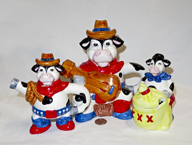 |
No farmers these, rather cowboys (and girl). They are from Russ Berrie Co. which Wikipedia tells us was named after its founder, Russell Berrie (1932-2002) and began as a mker of stuffed animals, toys and gifts. AS it became focused on play items for infants and juveniles it acquired Sassy Inc in July 2002, Kids Line LLC in Dec 04 nd CoCaLo Inc and LaJobi Inc in April 08. "In December 2008, the company divested its gift business operations to The Russ Companies, Inc. (TRC),[3] previously The Encore Group. The Company retained the Russ and Applause brands, and licensed them to TRC. By April 2011, The Russ Companies filed for Chapter 7 Liquidation Bankruptcy and no longer exists as an entity." In Sept 09 Russ Berrie and Company changed its corporate name to Kids Brands Inc. |
|
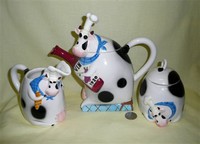 |
Loblaws Inc of Canada designed this cute Chef set (French Chef of course), © 2007 and stamped “Life@Home and La vie @hez soi”, ‘spring meadow’ théière (Produit de Chine, of course…). Loblaws started in 1919 in Toronto as something new for the time – a ‘groceteria’ which combined self-service and cash and carry. They weathered hard times by introducing many innovations (including No Name products, President’s Choice, banking, and more recently Joe Fresh Style clothing), and today operate a successful chain of ‘market’ stores. For us Yanks that aren’t familiar with them, there’s a fun history of this innovative company on their great web page at www.loblaws.ca. I’d like to thank them for one of the neatest cow teapot sets I’ve seen in quite awhile. |
|
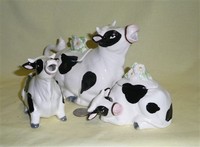 |
This set comes from Andrea by Sadek, per their web page: “also known as the Charles Sadek Import Company or j. willfred, Andrea by Sadek is a product line with over 2,000 products in 20 categories.” They were made in China. There are several other cows from this gift and tableware company scattered through out the web site. |
|
|
This flat-faced group is part of a “Grandeur Gift Set” by “TOP maestro”, made in China. In addition to these pieces the set contains 4 cups and saucers. |
||
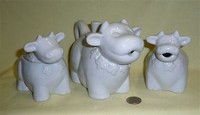 |
This unmarked, though likely post-war Japanese, set is of very heavy ceramic. The teapot still bears a few signs of black cold paint. |
|
|
This set, which has a huge salt and pepper as well as the pitcher, sugar and creamer, bears an impressed “Japan” on the base. It would appear to be designed to resemble the cows popularized by geo. z. lefton, see the Brands theme. |
||
 |
This pristine, never used set that’s about a decade or more old comes complete with salt, pepper and cups and is marked for Otagiri. Another one of the teapots and the little girl creamer were in the ‘Brands’ theme where that company was described. I got those two separately, but was pleased to be able to get a full set. |
|
|
||
|
||
|
Yet another older Japanese set - this one bears a sticker from Thames of Japan. Sort of cute, but awkward to use. They must have been fairly popular in their day because they come up not infrequently on Ebay. |
||
|
Never waste a good mold. Here's the bottom, 'teapot' cow from the stack above, in black with mostly rubbed off gold trim |
||
|
This is another interesting old Japanese made tea set, with just heads for the creamer and sugar. It has a rectangular blue sticker with a white rim and “Japan” in white. |
||
|
These ladies in their pearls and fancy hats – teapot, pitcher and creamer - bear a made in China sticker. They came from Australia via eBay. |
||
|
Here is another set of teapot, pitcher and creamer, by Henrikesen Imports, Inc, made in Japan. The pitcher and creamer are also shown in the Pitshers page, but I've included them here with the much more recvently acquired teapot. |
||
|
These are from Otagiri, now one of the Enesco brands of ceramic collectibles. The design is copyrighted for Elizabeth King Brownd, and they were manufactured in Malaysia. As noted in Favorite Brands, Oragiri has produced quite a few cow creamers over the years. |
||
|
Two more from Otagiri, these made in Japan. They are marked for 'Fiona Stokes, J. Papel'. A quick web search turns up a cow mug and a cow on a music box also wearing the red moon sneakers. It also seems that Fiona Stokes-Gilbert is a Los Angeled based designer of cunsumer products and textiles. I think this is her only cow. I don't understasnd the S. Papel bit, but it seems to be attached to the red sneakers items only, best I can tell. |
||
|
||
Two farmers with corn - one offering it, the other buried in it. | ||
Two more farmers. The holstein in blue coveralls that's just sort of standing there hails from Savoy Housewares. The one with carrots seems to have charmed a bunny. |
||
This pudgy farmer bearing flowers is marked for "Young's, China".. | ||
|
This unmarked white and black cow seems to enjoy being milked. |
||
|
These two cows seem to have outgrown their barns. The one on the left has a blue and white sticker from “The Manual Woodworkers and Weavers Inc” (what they’re doing with a cow in a barn is beyond me), and the one on the right is impressed with “Mercuries 1994” and has a gold Mercuries, Allentown, Pennsylvania, Made in China sticker. A web search failed to find any remains of Mercuries, but MMW as the Manual Woodworkers and Weavers of western NC is now branded, and which has been in business since 1932, has been run since 2008 by the third generation of the founding Oates family. They now claim to be the nation's leading supplier, manufacturer and distributor of printed and woven textile based products, and even have a facility in Germany to serve international customers. No more cows in barns can be expected from them, but there seems to be an offshoot called 'Manual' that has a huge catalog with all kinds of stuff including ceramics, so I guess there's still hope. |
||
|
||
|
||
|
Mr and Mrs Farmer each have their own bawling calf. I got him many years before I found her - and initially wasn't quite sure what he was doing to the poor little animal. |
||
|
This pudgy Blues Brothers saxophonist comes from Omnibus, ©OCI, and was made in the Philippines in 1993. |
||
|
||
White dealing witrh cowboys, here is a Texas sized tea - rather coffee - pot with accompanying pitcher that I gor a decade ago. They are made by Hiorton Ceramics, and about the only information on the web is that "Horton Ceramics was started in Eastland, TX right after Horace returned from WWII in 1946. He and his wife, Geraldine, started Horton and sold their products up until 1964. Horace and Geraldine's daughter, Toni Horton, is active on Facebook and posts about her family's business." |
||
|
Zis vache ees ze French producteur de lait…or so she appears to be, sporting a pink beret with blue overalls. Made in China, of course. |
||
|
We have to cross the Channel to England for this natty gentleman. At least, that’s where he came from to my collection (though I suspect he wasn’t made there) |
||
| Back to the US for at least the designer of this one, albeit it's an Enesco product, made in Taiwan in 1993. It's by Mary Rhyner-Nadig who designed a whole flosk of her "Moo-Moos", but as far as I know no creamers and only this one teapot. The rest seem just to be kitchy figurines. There's a collectoir;s club although they are only on facebook and I don't do that so can't tell you any more about it or her, except that they are no longer in production. | ||
|
||
|
This hefty dancing pair is from The Good Company, a division of Applause, Inc. It’s dated 1989 and was made in Korea. The accompanying creamer and sugar are in their best duds. |
||
|
This cow on wheels tolerating a cat comes from the Certified International Corporation, © Susan Winget, and was made in Thailand. |
||
|
This is just a nice simple red and white cow teapot with a spherical body, marked only "A3". |
||
|
This is “Sunshine”, or so it’s inscribed on the bottom…made in Taiwan. I must admit I don’t get the connection between the name, the chef’s hat, the overalls and the pitchfork. Not the world’s most beautiful cow teapot, but it is big… |
||
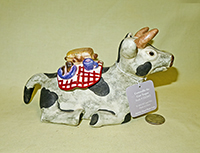 |
As the purple tag says, this is Cornwallis the Cow Teapot, copyright 2002 from KT and TEG, Made in China. On the other side it says ENCORE presents Kelly Theodore creations. Cornwallis is all ready for a picnic. |
|
 |
These two rotund ladies are out shopping. The one on the left has found some asparagus, and the other has something I can't identify in hetr basket. Sher bears a green and gold sticker for Gempo Giftware, is stamped for Japan and has an impressed crown with an 'R' in it. |
|
|
It was the cow creamer that induced this purchase – albeit it’s a lovely Peter Rabbit rendition in its own right. The Beatrix Potter figures were initially made by Beswick (see Favorite Brands), but they were bought by Royal Doulton in 1969. This set dates from 1998. |
||
|
||
|
This teapot is entitled “Fun at Breakfast” and was made in Thailand ‘exclusively’ for Debenhams, the UK Department store. |
||
|
No, it’s not a pig, it really is a cow…you can tell because it has horns. There is, however, a pig version which looks very, very similar…both by Roman, in their Patchwork Giftware line. Roman, Inc. is an Illinois-based producer and distributor of giftware and accessories. |
||
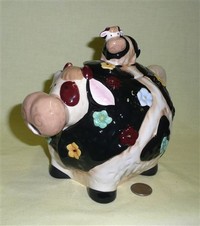 |
This lumpy cow with flowers and a baby riding on top was made in China for Collections, Inc. Although it’s sort of cute I’m not overly pleased with it, for two reasons – first it’s marked ‘for decorative purposes only’ – and what good is a teapot in which you can’t make tea? And second, it’s poorly made – when it arrived, the lid wouldn’t fit properly on to the pot. I had to do a bit of surgery with a dremel tool to get it to fit. |
|
 |
Although unmarked, I’m almost positive that this purple and yellow caricature comes from Ucagco, made in Japan. There are three sets of Ucagco cows as well as a bit of information about the company about halfway down on the sugar and creamers page, as well a fair number of their cow creamers scattered through the Modern Variations pages. While they used several different molds, all are more or less similar in style, with the bulgy eyes, bulbous nose, and a rope and bell around the neck. |
|
|
This little purple and white cow with the tree on its back was made in Taiwan. I’ve had it since ’95, and umpteen years later I still don't pretend to understand it. |
||
|
||
|
||
|
||
|
||
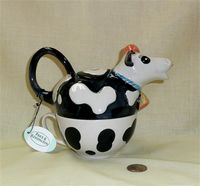 |
This and the next few pictures include a number of tea-for-one cups and pots. This one is from Price and Kensington, one of the traditional potteries of Stoke on Trent. Its tag says that P&K is part of the Arthur Wood Group; trying to find them on the web, it turns out that they in turn have been acquired and are now part of the Rayware Group (www.rayware.co.uk). There has apparently been a lot of consolidation and re-shuffling (along with closures) in British ceramics in the last few years. The Rayware web site notes that the Arthur Wood Company was founded in 1884, and that the origins of the Wood family go back over 250 years to the famous master potters Ralph and Enoch Wood. |
|
|
||
|
This cross-eyes, big eared fat bellied tea for one is marked for Bella Cassa, by Ganz. It's not at all clear that it would make my cassa very bella, but then to each his own taste. |
||
Zow Cow, another three-piece black and white spotted ‘tea for one’ lid, pot and large cup, came from Italy in summer ’07. Its box informs us it’s “Zoo tea, Teiera e tazza in ceramica dipinta." |
||
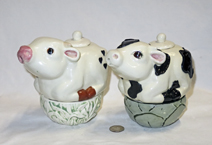 |
These two pudgy calves differ only by decoration, and neitger have any marks. There are however companion pig and bunny versions. |
|
|
This cop/pot is identical to the black and white one above but for the color of the cup. The cups seems to bet lost or broken frequently, because I've seen a number of just the calf for offer on ebay. This one is sitting next to an unmarked ceramic cow whose lid is the top of its head. |
||
|
The tea-for-one on the left with the ever-popular rooster on its back is standing next to a pitcher in the same pattern, by Dennis East International, Inc, ©2002, Made in China. |
||
|
These two are, as far as I know, the only teapots from Cows on Parade. “Where’s the Beef” is on the left, and “Fruits of Summer” on the right. They’re marked “©2000 CowParade Holdings Corporation, China”. |
||
|
The orange and white teapot on the bumpy brown base is by Moorland, from “Staffordshire, Chelsea Works Burslem, England”. A black and white version, along with a matching creamer, is shown in Favorite Brands. Moorland pottery was established in 1990, and they have since been restoring their old factory and bottle kiln. From their website they seem to specialize in personalized mugs from around the UK, with a few other things thrown in. The splotchy blue teapot, which appears to be from an identical mold, is unmarked, but is presumably also one of theirs.. |
||
|
These two smiling caricatures it are both from Wood Pottery of Burslem. As noted above, the Woods of Burslem date back to the three brothers Ralph, Aaron and Moses, born in the early 1700s. The potteries web (www.thepotteries.org) site has quite a bit of information about them (and many other famous Staffordshire potters…and it lists some 32 Wood’s, including a Tony Wood whose studio produced a number of creamers in my collection…at any rate, more than enough Woods to thoroughly confuse me), including the tidbit that “Wood & Sons called in the receivers in February 2005.” |
||
|
||
|
|
Some cow teapots wear bandanas…the one on the left with the yellow bandanna is from "Cook’s Club, Quality & Design, Taiwan". It's neighbor with the red bandana is also from Taiwan, but the one standing in grass is unmarked… |
|
|
||
|
Yet more bandannas, the one on the left from "Oriental Eagle" accompanied by an unmarked one with grey spots and a very flat nose" |
||
|
No bandannas this time, but neck gear nonetheless. The one with the yellow necktie is by Standrd Specialty Company and was made in Taiwan. Its pink toed companion sitting on a flower is unmarked." |
||
Two kneeling cows here.. The little one on the left with the white daisies on her lid is from Andrea by Sadek, made in Japan. I may have provided this info elsewhere, but...a web search yields "Andrea by Sadek, (pronounced AN-dree-uh by Say-dek), also known as Charles Sadek Import Company or J. Willfred is headquartered in New Rochelle, New York. The company was founded in 1936 by Charles and Norman Sadek and is still owned and operated by the Sadek family. Currently [circa 2019] Charles' son, Jim, his wife, Sandra manage the day-to-day operations with a faithful staff of customer service reps, shippers, designers and product developers. The namesake of the company, Andrea, is Jim's sister and Charles Sadek's daughter; she is heavily involved in the design of Sadek's products." The lovely cow on the right is marked “Design by Greg M Vale for Martinvale, Made in China." Yer another trip to the web tells us that Greg Martin Vale is an artist from Kiama New South Wales, and that Martinvale has for over 30 years been a NSW supplier of gift and housewares. One assumes from the similarity of names and location that there is some connection. |
||
This flowery lady is “Sweet Bessie’s Bouquet, © 1996 Karen Bell, Licensee, Giftcraft Inc, 14120, Handpainted in China”. Per a web site in her name Karen Bell is a ceramic sculptress from Arizona who specializes in reptiles and amphibians. At least that's what the web turned up. Maybe there is another Karen Bell, or maybe Sweet Bessie the cow is actually an amphibian in disguise. Mystery. Nice pteapot at any rate. |
||
Another cos with a flower garland, this time a somewhat bemused holstein, made in China and for decoration only it says, apparenly per the tag because the handle gets very hot when it;s filled with hot tea. |
||
|
||
|
||
|
This is a rather nice if unmarked interpretation that deserves a little section of its own because it's the only teapot in my collection that has a black and blue bumblebee on the lid. Also, interestingly, it met my initiaL rule of <$10. |
||
|
||
|
||
|
||
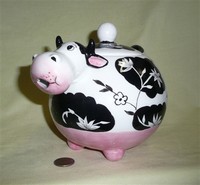 |
And another, this one Made in China but bought from an Australian seller. |
|
|
Yet another Made in China, unusual only in that she has a double bell. |
||
|
These two are beyond chubby – pudgy, maybe. Neither is marked. |
||
|
Cows with cows – two interpretations of calves getting a lift from Mom. The one on the left is from EDC, Made in China; the other is unmarked |
||
|
.The two larger standing caricatures, onein grass next to a matching smaller sitting up creamer and the other with white stars for a necklace, are made of very thick ceramic. They are all colored with what is called ‘cold paint', meaning applied over the glaze; thus it rubs off easily. Although unmarked, from the nature of the paint and the material, I’d guess they were fairly early post-WWII Japan. |
||
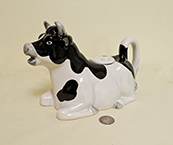
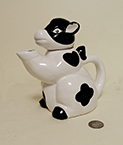
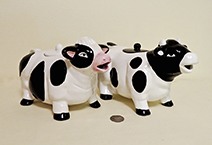
|
||
|
The winsome looking fat hornless cow on the left is unmarked. Its neighbor, whose white horns are curled forward and touch in the middle making its head look flat, has Japan inscribed on the base and at one time bore a green sticker on its rump that proclaimed it is Old MacDonald by Westwood. The only Westwood I’m aware of is Westwood Ware of California, active in the 1940s and 50s – but their goods were all made in California as far as I know, so this maker remains a mystery. |
||
|
This quite small caricature bears a decal that reads “Editions Atlas Collections” and came to me from France. From a web search we learn from www.closinglogos.com that "Editions Atlas is a French company specialized in collections and mail order. It was founded in 1954, but got their current name in 1975. They were purchased by Italian multi-national company De Agostini. They released magazines about various subjects, such as cinema, travelling, model construction, history, geography, photography, and many others." As is often the case these days, in the US as well as from other countries, the postage cost more than the cow. |
||
|
||
|
||
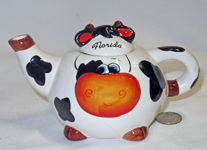 |
This small one could easily go on the Advertising and Souvenirs page since it says "Florida: on the lid. Given that, I expect the large nose is supposed to look line an orange.. |
|
|
||
|
These are metal whistling tea kettles, quite widely available. The one on the left is Copco’s “Mrs. Moo”, and the one on the right from Kammenstein. Both are made in Taiwan. |
||
|
I found this one in the fabulous Old Forge Hardware Store in the NY Adirondacks. Its box says, “Supreme Housewares, Made in Taiwan”. I tried it, and when the water boils it does indeed say “moooo…”, albeit at a rather high pitch. They also make them shaped as roosters, giraffes, and mallards. Their (wholesale only) website states “Supreme Housewares contain products that are never ordinary and always entertaining. About 14 years ago (meaning @1996) the vision of Supreme Housewares began by Michael Chen (CEO), who devotes time and product development to new products each year”. They operate out of Fremont, CA. |
||
|
It turns out that Supreme Housewares makes cow tea kettles in more than one style. This one is shown with its head up. |
||
|
I generally have tried to avoid teapots with just pictures of cows – but the head of one on on the left is sticking out so it sort of counts, and the one on the right came as part of a set with a couple pitchers. |
||
|
||
|
These cow-jumped-over-the-moon teapots don’t meet my criteria and I wouldn’t have gotten them if there was only one version, but as you can see there are at least three. Hey diddle diddle is popular with kids, so these were most likely designed for children’s teas. From top to bottom they are from Blue Moon (complete with tea), Dept 56 (front and back), and Wang’s International. |
||
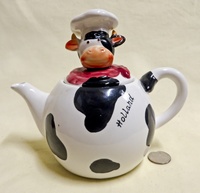 |
I never should have bought this one – don’t usually go for ones with just the head of a cow – but I guess I was intrigued by the fact that something as hokey as this would be marked “Holland”. And sure enough, on the base it says “Blue Delft, Deco, Handpainted, Holland”. At 5 GBP it was cheap enough, although the shipping cost was horrendous. |
|
|
Here begins an area with a number of oriental teapots - first a couple most likely from Japan, then three from what's probably India or Southeast Asia, then a whole bunch from China. This lovely Japanese (I think) interpretation came from an antique mall in Annapolis, MD. Can anyone help with the writing? |
||
|
This beautiful Japanese cow porcelain teapot was soldas Meiji, pre-1893. The antique dealer seemed to know what he was talking about - it's certainly high quality, unlike anything from recent eras. I was also features on the 'places' page as a fine example of Japanese ceramic art. |
||
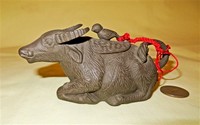 |
This small and very nicely crafted water buffalo teapot with a bird on its lid that’s lashed to its tail with a red macramé string is fashioned from hard dark clay and is chased in an interesting pattern. It’s quite small and could serve as a creamer, but it’s much more likely that it was designed to hold tea. It has oriental writing – Japanese I believe – on the bottom. |
|
|
Here is an unmarked, sacred or mythical cow. It looks to me like it might be from India or Indonesia. |
||
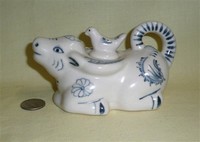 |
This is definitely a water buffalo – it came to me from Australia (via eBay), so although it’s unmarked, and very heavy ceramic, I suspect that it was probably made in Indonesia, Thailand, or somewhere in that vicinity. |
|
 |
This recumbent bull is clearly marked: “Pure Ceylon Tea packed in Sri Lanka by MlesnA (Ceylon) Ltd, Manufactured by Lanka Porcelain (PVT) Ltd, Sri Lanka”. And indeed, it is full of tea. Hitting the web, we find that "Noritake Lanka Porcelain Private Limited is the pioneer porcelain tableware manufacturing conglomerate in Sri Lanka. The Company was established in 1972 as a joint venture company between Ceylon Ceramic Corporation and Noritake Co., Limited of Japan. Noritake Co., Limited of Japan is a hundred years old company which markets tableware under the brand "Noritake" all over the world. The Company's production facility is located in Matale where country's rich minerals such as quartz, feldspar and dolomite deposits are spread." |
|
|
||
|
||
|
||
 |
This one is definitely a bulgy-eyed cow (or bull), with a water buffalo on the lid. It came straight from Beijing (via eBay), at the price of $.01…but with a shipping cost of $43. Worth every penny, as they say. |
|
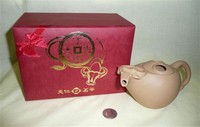 |
I think this is a quite lovely modern Chinese interpretation…and it came in its own padded box. |
|
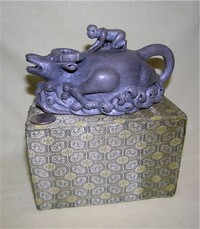 |
This Chinese one is also boxed, but is hardly lovely. It’s very heavy, of some unidentifiable grey material – and the ‘cow’ or water buffalo has a body that’s very rat-like. It’s about the meanest cow in the barn, from the looks of the teeth. Truly weird. And it came to me from Australia. |
|
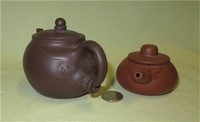 |
The lovely, simple little Yixing purple clay teapot on the right here came to me from Hong Kong. Yixing clay teapots are quite popular these days because their unglazed surfaces absorb traces of the tea, creating a more complex flavor…but for that same reason they should always be used with the same variety of tea, and never washed with soap. This type of clay derives its name from the location where it’s found, a region near the city of Yixing in Jiangsu Province. The Wikipedia article about it states that its use dates back to the Song dynasty. Its companion teapot on the left arrived from a much less exotic place – Texas – although the seller was Chinese. It’s delightfully unusual in that the cow or water buffalo head embellishes the handle rather than serving as a spout. |
|
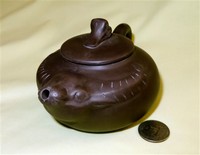 |
This one has the same face as the one above that has the head on the handle, but here it serves the normal function of a spout. |
|
|
||
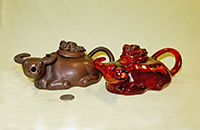 |
These are two identical and fairly large interpretations of the reclining water buffalo with a napping boy on its back. One is of dark red clay, and the other was sold as ‘amber’ – yeah, sure…amber colored plastic that is. The clay one came from Beijing, and its amber cousin from “Zhujinlin, Shifosi Zhenping, Nanyang Henan China”. |
|
|
||
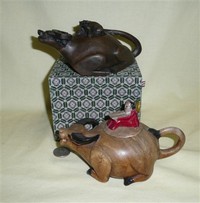 |
Two more: a heavy brown kneeling stone water buffalo with a straddle-legged bull riding its lid, and a somewhat different Asian interpretation, also stone of some sort and interestingly colored – with a disjointed front leg (shouldn’t bend that way) and a stoic red coated oriental man along for the ride. |
|
| My son found this one in an antique store - it's like the light brown one above, with the man (here uncolored) peacefully reading a book while his water buffalo rests. | ||
|
||
These two are a quite different interpretation of the boy n the water buffalo - here they are resting peacefully in their backs. The lovely brass one on the left came from Singapore, suring the same 2001 trip when we got the ones above in Hanoi. Its purple clay companion on the right came from the Freer Gallery of Asian Art in Washington, DC. It's a lovely museum and we were dlighted to find this in its gift shop. |
||
|
||
 |
These two are from identical molds, but one is said to be Tibetan silver, and the other is copper. Both bear a 4-symbol Chinese mark in a square on the bottom. They are quite nicely sculpted, with considerable detail on the tree and the boy on the lid. The boy with the flute riding a water buffalo or bull is a traditional Zen Buddhist theme – you can read more about this on the Suiteki page. The copper teapot here was somewhat corroded so I took a bit of polish to it – it also has a considerable amount of solidified material of some sort inside, so I doubt that it was really used just for tea. Both came via eBay from Nanyang City, Henan, China; interestingly the seller had simultaneously listed the silver one for $ and the copper one for £, probably not expecting some foolish collector to search ‘worldwide’ and decide to get both. | |
|
||
|
||
|
To close out teapots, here are two fake collector’s versions, both by Nini, a company that makes a line of these in a variety of shapes. |
||
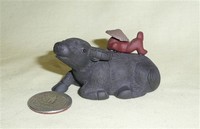 |
This is a rather delightful little water buffalo with the boy resting on its back, and is included to remind me to read the eBay adds more closely…once it arrived and I found it had no holes, I got ready to chew out the seller for misinformation but on closer inspection found that it was described as a “tea pet”. I’m not sure what a tea pet is supposed to be or do, but I now have one. At least it’s small and doesn’t take much room on my ‘whoops’ shelf. |
|
